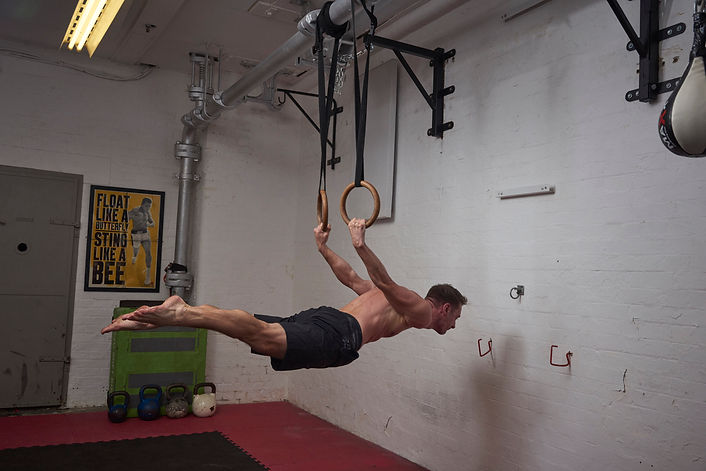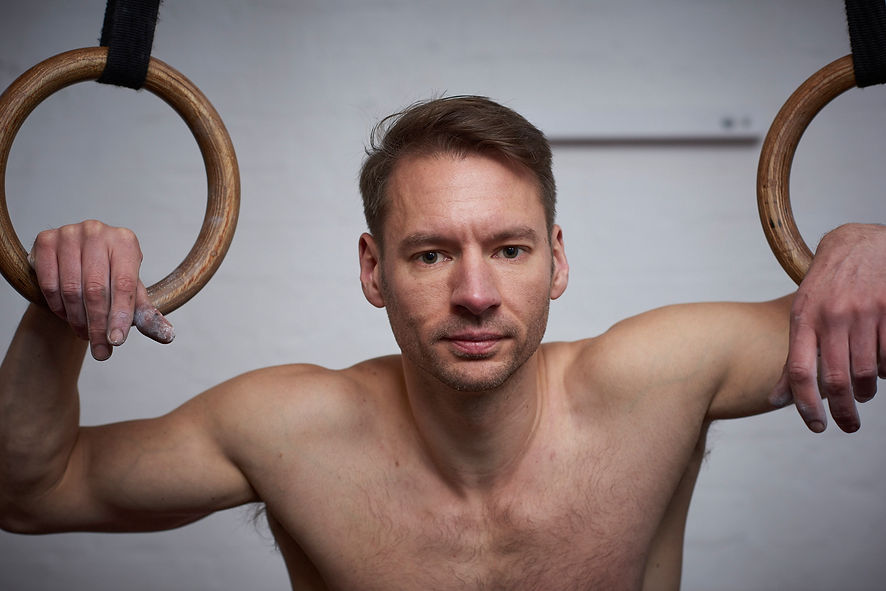Gymnastics
Hints & Tips
MUSCLE-UP WITH GRACE - BECAUSE THE WORLD’S UGLY ENOUGH WITHOUT BUTCHERING BEAUTIFUL THINGS
There are enough ugly things in this world without you making more with your hideously ugly swinging muscle-up. So here's a quick guide to the perfect graceful

.png)
I CAN'T STAND UP (FOR FALLING DOWN)
AS A gymnastics coach I’m increasingly filled with a strange mixture of joy, apprehension and revulsion when I walk into commercial gyms and see misguided members throwing themselves into - and quickly out of - handstands.
Whether the recent surge in popularity of handstands is down to Cross-fit or outdoor calisthenics groups such as BarStars, the end result is the same - ugly, and more worryingly potentially dangerous handstands.
A good handstand should be a joy to behold; still, steady and seemingly effortless, it exudes gracefulness and delights observers with its long, clean lines.
But poor teaching and an even poorer understanding of the basic principals means many attempting handstands face a future filled with failure and frustration, not to mention potential injury.
In fairness this is hardly surprising considering how much more difficult it is for an adult to master a handstand than it is for a young.
With this in mind I thought I’d try and distill my handstand knowledge into easily digestible form that would hopefully help the learner enthusiast.
First a quick look at the theory behind the handstand.
THEORY
From a theoretical standpoint the handstand is quite straightforward. It’s simply a matter of using the principals that govern our ability to stand on our feet and applying them to a slightly smaller base of support - i.e our hands – while being upside down.
The golden rule is that if you want to stay on balance you have to keep your centre of mass (which is a point just above your belly button) inside your base of support (this is the area around the parts of your body that touches the ground).
If any part of your body part goes outside of your base of support this has to be counterbalanced by another body part of equal magnitude.
Of course, as we can all testify to, there is a massive difference between theory and practice. In practice:
·we are dealing with not only a much smaller base of support but also the fact that our upper limbs are far weaker than our lower ones.
· our lower limbs also weigh a lot more than our upper ones do which means we are asking weaker muscles to do more work.
· our ‘core’ has never had to deal with the levels of instability that they will face with us on our hands.
· All of this is happening while we are upside down so what was forwards is now backwards.
· our heads are now a lot closer to the ground, in danger of being crushed on by almost our entire bodies and we’re relying on some tiny little limbs that up until now have only been used for carrying keys and phones. To say your brain is a little scared, worried and confused is something of an understatement.
With that in mind there are a couple of problems that most, if not all, beginners face and benefit hugely from addressing. I’ve even included some solutions for you lucky people.
.png)
Problem 1 – Poor shoulder flexibility leading to a closed shoulder angle
In my experience this is without doubt the biggest stumbling block that adults, and in particular athletes, will face. Very few sports require extremely mobile shoulders. As a result most of us lack the ability to hold our upper arms by our ears – the position that we need for a good handstand. After the wrist the shoulder is the angle closest to the floor which means that any problem in the shoulder is amplified and has to be corrected further up the body.
This is not to say that someone with a limited shoulder extension will never be able to hold a handstand. It just means they will be banana shaped at best. This then becomes a problem when you want to try more advanced moves such as handstand piruettes, swing to handstand on parallel bars and handstand on rings. In these cases anything other than a beautiful handstand will lead to problems.
SOLUTION
A lot of stretching, traditionally bridges are the go-to stretch while dis-locations and in-locations with a dowling rod is also a very good exercise. A more office-friendly excellent stretch is with straight outstretched arms pushing into a desk with your palms then relax and try and push your chest towards the floor.
The good news for all your Cross-Fitters out there is that the mobilization work you're already doing for overhead squats and snatches will help you with your handstands.
Problem 2 – Hands pulling upper arms away from ears
Another common mistake associated with the shoulder angle but this time the problem isn’t due to a limited flexibility. Instead it’s the natural instinct of ensuring something is going to stop you from face-planting the ground.
The ideal handstand shoulder alignment requires your upper arms to be locked by your ears. While this is fine while you are upside down this has quite frightening implications during the step to handstand phase. With your shoulders in the proper position you are now faced with a step to handstand in which your eyes will not be able to see your hands touch the floor. Although they most definitely will be there your mind is initially not too keen on taking your word for it.
The result is that you a) naturally close and break the shoulder angle to place your hands on the floor b) arch your head back and up to see the floor. Both these actions compromise your starting handstand position meaning your hips will be too far behind your hands requiring you to arch your back to find any sort of balance.
SOLUTION
No easy answer for this one I'm afraid. My advice is to take your handstand back a step and practice against a wall. This time squeeze your ears with your upper arms and work and maintaining contact as you reach for the floor. If you do this successfully you shouldn't see your hands make contact with the floor and instead you should feel your hands touch the floor. You might find your hands hitting the floor with a fair amount of force to begin with but as time goes by you'll be able to lighten this contact. Bending your lead knee more to get your torso closer to the floor will also help.


Problem 3 - Not enough body tension
Keeping a high level of tension throughout your body when trying to hold a handstand is critically important. Without tension your limbs will start to move and while this might not be an issue for a squat or chest press in the handstand movement is catastrophic. A small movement will quickly grow, reverberating throughout your body causing compensation and counter-compensation until you quickly topple over.
Good body tension means locked shoulder pushing into the floor, a tight ‘core’ – think belly button to spine – buttocks squeezed together and tensing the thighs. A good tip is to imagine trying to hold a piece of paper between your upper thighs.
The importance of tension cannot be over-estimated. Lose it and you’ll lose your handstand.
SOLUTION
While using the wall for support try and identify different parts of your body and tighten and relax them. Then try tightening them and holding for 10-20s. Progress to trying to hold two body parts tight.
Practice these three simple points and I guarantee you’ll see a massive difference in your handstands - and you’ll never have to worry about bleeding all over the gym floor again.




